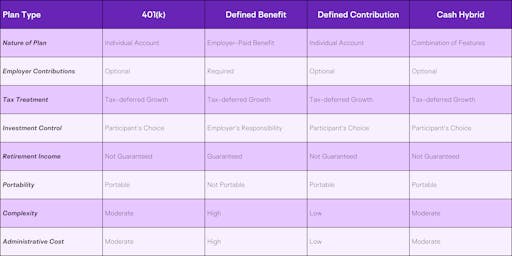August 8, 2023
How Self-Employed Can Save For Retirement Today

Introduction
When we talk about S-Corps, we usually address the most common benefit, the limited exposure to self-employment taxes that can save the taxpayer thousands of tax thousands of dollars every year. But what can you do if you're a high earner and your revenue for the last few years exceeds $500k, or at times $900k?
As a high earner, you'll take a higher wage of $200-$250k, pay self-employment tax in full, and even max out 401(k) contributions; but you still won't move the needle in tax savings. One strategy for a high earner can be a DB Plan (A Defined Benefit Plan for S Corp), or what we refer to in our professional language as a 401(k) on steroids. This is a plan that allows you to defer each year's higher amount of revenue, contributing to your retirement plan.
Fundamentals of 401(K)
Before we explain more about the benefits of Defined Benefit Plans, let's review the fundamentals of the beloved 401(k): From about $100,000 in net income up to $284,000 the 401(k) plan helps to reduce your personal tax liability in two major ways:
- You as the employee of the S-Corp can contribute to your retirement through the payroll, much like a W2 employee at a Fortune 500 corporation would be able to.
- Your S-Corp, as the employer, would also be able to MATCH those contributions - profit sharing, up to the yearly limit ($57,000-$63,500 depending on age)
As the employee of the S-Corp you can contribute up to $19,500 of your salary to the 401(k) (with an additional $6000 if over 50, called catch-up contributions), and with a Profit-Sharing Plan the company can contribute up to $37,500 of company profits or 25% of compensation (see salary).
Benefits of an S-Corporation
S-Corps can be a secret weapon for self-employed. They offer significant tax benefits and lessen your self-employment taxes owed at the end of the year. You’ll have better access to benefits, protection against your assets, and credibility in your industry. But all those fantastic benefits come at a cost. The incorporation and complex compliance rules require both time and money for setup and ongoing maintenance of the business to comply. You’ll need excellent bookkeeping practices as well and a way to issue payroll for yourself.
But the benefits can significantly outweigh the cons. Some of the benefits include tax savings, access to corporate-level benefits, increased credibility, and more. When it comes to retirement savings in particular, self-employed are able to contribute more to their retirement by contributing as both the employee and employer of their business, ensuring they are making max contributions that set up their future success and help reduce their current tax liability.
Why should someone consider a retirement strategy beyond just a 401(k)?
The contribution limit of a 401(k) by itself is $66k for 2023 (under 50 years old) or $73,500 (50 years and older), and the contribution limit of a Cash Balance (defined benefit) plan is anywhere from $89,000 to $372,000 a year. By adding a Cash Balance (Defined benefit) plan, the new maximum contribution range could increase from $155,000 at age 35 all the way to $471,000 a year at age 70, which could defer federal income taxes of an estimated $198,000 year(based on a 42% tax rate) until retirement.
Let's look at an example: John is a 55-year-old real estate agent making $285,000 per year after expenses (including payroll of $125,000 for himself since he runs an S-Corp). With a 401(k) by itself, he would be able to contribute a total of $30,000 from his wages as the employee; and $31,250 as the employer for the year.
In adding a Cash Balance plan to go with his 401(k), he could add an additional $168,126 contribution as an employer to the retirement savings of the 401(k), bringing the total contributed to retirement to $229,376 per year. And that limit only goes up: as John gets older and his business potentially continues to get more profitable, he could have the ability to pay himself a higher salary and increase the amount contributed to the plan.
This above example is intended for educational and illustrative purposes only and is based on current maximum contribution limits for 401k and Defined Contribution plans (10/2023). The scenario above should be considered in context with holistic wealth management, tax planning, and other factors when determining if this approach is right to achieve your long-term goals.
401K and Defined Benefits Plan
Definition and description of 401(K) and Defined Benefits Plan
Solo 401(K)
A Solo 401(k), also known as an Individual 401(k) or Self-Employed 401(k), is a type of retirement savings plan designed specifically for self-employed individuals or small business owners with no full-time employees, except for a spouse. This retirement account allows the individual to make contributions both as an employer and as an employee, enabling higher contribution limits compared to traditional IRAs or other retirement plans.
Defined Benefits Plan
A defined benefit plan is a type of employer-sponsored retirement plan that promises specific retirement benefits to its participants based on a predetermined formula. In contrast to defined contribution plans where the eventual benefit depends on the contributions and investment performance, a defined benefit plan guarantees a certain benefit amount upon retirement.
Major differences between typical defined benefit plan and 401(k) plan
There are four major differences between typical cash balance plans and 401(k) plans:
- Participation - In typical cash balance plans, employees' participation does not hinge on contributing a portion of their earnings to the plan. Conversely, in a 401(k) plan, an employee's participation partly or entirely relies on their decision to make contributions to the plan.
- Investment Risks - Cash balance plans have their investments overseen either by the employer or an appointed investment manager, with the employer assuming the risks associated with these investments. On the other hand, 401(k) plans often offer participants the freedom to make investment decisions within specified categories. Under these plans, participants take on the risks and rewards linked to their investment choices.
- Life Annuities - Unlike 401(k) plans, cash balance plans are required to offer employees the ability to receive their benefits in the form of lifetime annuities.
- Federal Guarantee - Since they are defined benefit plans, the benefits promised by cash balance plans are usually insured by a federal agency, the Pension Benefit Guaranty Corporation (PBGC). If a defined benefit plan is terminated with insufficient funds to pay all promised benefits, the PBGC has authority to assume trusteeship of the plan and to begin to pay pension benefits up to the limits set by law. Defined contribution plans, including 401(k) plans, are not insured by the PBGC.
Defined Benefit Plan
A defined benefit plan is a type of employer-sponsored retirement plan that promises a specific, predetermined retirement benefit to its participants upon reaching retirement age. In contrast to defined contribution plans where the eventual benefit depends on the contributions and investment performance, a defined benefit plan guarantees a specified amount or a formula-based benefit.
Defined Contribution Plan
A defined contribution plan is a type of retirement plan in which contributions are made by both the employer and/or the employee. The eventual benefits are based on the total contributions and the investment performance of those contributions over time.
In a defined contribution plan, the contributions made during a person's working years are accumulated in an individual account for that employee.
Unlike the Defined Benefit Plan, you set the amount you want to contribute each year based on your income. This allows for some cashflow flexibility but also makes it less certain you'll reach the total amount you need to retire with.
The main distinction between defined contribution plans and defined benefit plans is that in a defined benefit plan, the retirement benefit is based on a predetermined formula, such as years of service and average salary, rather than the amount of contributions and investment returns.
Cash Balance Hybrid Plan
A cash balance hybrid plan for the self-employed is a retirement savings option that combines features of both a defined benefit plan and a defined contribution plan. It is designed specifically for self-employed individuals or small business owners who want to maximize their retirement savings in a tax-efficient manner.
In a cash balance hybrid plan, the retirement benefit is determined by two components:
- Defined Benefit Component: Similar to a traditional defined benefit plan, the plan promises a fixed benefit to the participant upon retirement. This benefit is typically calculated based on a predetermined formula that takes into account factors such as the participant's age, compensation, and years of service.
- Cash Balance Account: In addition to the defined benefit component, the plan maintains an individual cash balance account for each participant. The cash balance account is essentially a hypothetical account that credits the participant with annual contributions and an interest rate that grows the account over time.
The annual contributions to the cash balance account are based on a percentage of the participant's compensation. For self-employed individuals, the contributions are typically made by the business owner as both the employer and the employee, allowing for substantial contributions.
The combination of the defined benefit component and the cash balance account creates a retirement benefit structure that offers the potential for significant retirement savings, tax advantages, and predictable retirement income. The plan provides the participant with a stated retirement benefit, while the cash balance account allows for more flexibility and portability compared to a traditional defined benefit plan.
Cash balance hybrid plans for the self-employed can be an attractive retirement savings option for high-earning individuals who want to contribute more to their retirement accounts than what is allowed in traditional defined contribution plans, such as SEP-IRA or Solo 401(k). However, the complexity of these plans and their administration may require the assistance of a qualified financial advisor or retirement plan specialist to ensure compliance with IRS regulations and maximize the benefits for the self-employed individual.
Pros and Cons Between the Plans

Conclusion
Want to learn more about which retirement plan is right for you? Schedule a complimentary session to meet with one of our Business Consultants.
Book Now